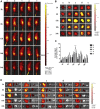Recent Progress of RGD Modified Liposomes as Multistage Rocket Against Cancer
- PMID: 35145405
- PMCID: PMC8822168
- DOI: 10.3389/fphar.2021.803304
Recent Progress of RGD Modified Liposomes as Multistage Rocket Against Cancer
Abstract
Cancer is a life-threatening disease, contributing approximately 9.4 million deaths worldwide. To address this challenge, scientific researchers have investigated molecules that could act as speed-breakers for cancer. As an abiotic drug delivery system, liposomes can hold both hydrophilic and lipophilic drugs, which promote a controlled release, accumulate in the tumor microenvironment, and achieve elongated half-life with an enhanced safety profile. To further improve the safety and impair the off-target effect, the surface of liposomes could be modified in a way that is easily identified by cancer cells, promotes uptake, and facilitates angiogenesis. Integrins are overexpressed on cancer cells, which upon activation promote downstream cell signaling and eventually activate specific pathways, promoting cell growth, proliferation, and migration. RGD peptides are easily recognized by integrin over expressed cells. Just like a multistage rocket, ligand anchored liposomes can be selectively recognized by target cells, accumulate at the specific site, and finally, release the drug in a specific and desired way. This review highlights the role of integrin in cancer development, so gain more insights into the phenomenon of tumor initiation and survival. Since RGD is recognized by the integrin family, the fate of RGD has been demonstrated after its binding with the acceptor's family. The role of RGD based liposomes in targeting various cancer cells is also highlighted in the paper.
Keywords: RGD peptide; cancer; integrin; liposome; nanomedicine; targeted therapy; toxicity.
Copyright © 2022 Sheikh, Alhakamy, Md and Kesharwani.
Conflict of interest statement
The authors declare that the research was conducted in the absence of any commercial or financial relationships that could be construed as a potential conflict of interest.
Figures






Similar articles
-
Increased tumor targeted delivery using a multistage liposome system functionalized with RGD, TAT and cleavable PEG.Int J Pharm. 2014 Jul 1;468(1-2):26-38. doi: 10.1016/j.ijpharm.2014.04.008. Epub 2014 Apr 5. Int J Pharm. 2014. PMID: 24709209
-
Enhanced anticancer efficacy of paclitaxel through multistage tumor-targeting liposomes modified with RGD and KLA peptides.Int J Nanomedicine. 2017 Feb 27;12:1517-1537. doi: 10.2147/IJN.S122859. eCollection 2017. Int J Nanomedicine. 2017. PMID: 28280323 Free PMC article.
-
Development of a novel cyclic RGD peptide for multiple targeting approaches of liposomes to tumor region.J Control Release. 2015 Dec 28;220(Pt A):308-315. doi: 10.1016/j.jconrel.2015.10.039. Epub 2015 Oct 23. J Control Release. 2015. PMID: 26526970
-
Safety of novel liposomal drugs for cancer treatment: Advances and prospects.Chem Biol Interact. 2018 Nov 1;295:13-19. doi: 10.1016/j.cbi.2017.09.006. Epub 2017 Sep 15. Chem Biol Interact. 2018. PMID: 28919304 Review.
-
RGD-modified polymer and liposome nanovehicles: Recent research progress for drug delivery in cancer therapeutics.Eur J Pharm Sci. 2019 Feb 1;128:8-17. doi: 10.1016/j.ejps.2018.11.023. Epub 2018 Nov 22. Eur J Pharm Sci. 2019. PMID: 30471410 Review.
Cited by
-
The Advancing Role of Nanocomposites in Cancer Diagnosis and Treatment.Int J Nanomedicine. 2024 Jun 19;19:6099-6126. doi: 10.2147/IJN.S471360. eCollection 2024. Int J Nanomedicine. 2024. PMID: 38911500 Free PMC article. Review.
-
Peptide-assembled nanoparticles targeting tumor cells and tumor microenvironment for cancer therapy.Front Chem. 2023 Jan 24;11:1115495. doi: 10.3389/fchem.2023.1115495. eCollection 2023. Front Chem. 2023. PMID: 36762192 Free PMC article. Review.
-
Carrier-Tumor Cell Membrane Interactions for Optimized Delivery of a Promising Drug, 4(RS)-4-F4t-Neuroprostane.Pharmaceutics. 2023 Dec 7;15(12):2739. doi: 10.3390/pharmaceutics15122739. Pharmaceutics. 2023. PMID: 38140081 Free PMC article.
-
Profiling target engagement and cellular uptake of cRGD-decorated clinical-stage core-crosslinked polymeric micelles.Drug Deliv Transl Res. 2023 May;13(5):1195-1211. doi: 10.1007/s13346-022-01204-8. Epub 2022 Jul 11. Drug Deliv Transl Res. 2023. PMID: 35816231 Free PMC article.
-
Hyaluronic Acid Hydrogels Hybridized With Au-Triptolide Nanoparticles for Intraarticular Targeted Multi-Therapy of Rheumatoid Arthritis.Front Pharmacol. 2022 May 27;13:849101. doi: 10.3389/fphar.2022.849101. eCollection 2022. Front Pharmacol. 2022. PMID: 35712709 Free PMC article.
References
-
- Aljabali A. A. A., Bakshi H. A., Hakkim F. L., Haggag Y. A., Al-Batanyeh K. M., Al Zoubi M. S., et al. (2020). Albumin Nano-Encapsulation of Piceatannol Enhances its Anticancer Potential in Colon Cancer via Downregulation of Nuclear P65 and HIF-1α. Cancers (Basel) 12. 10.3390/cancers12010113 - DOI - PMC - PubMed
-
- Alkabban F. M., Ferguson T. (2021). Breast Cancer. Cambridge Handb. Psychol. Heal. Med. Second Ed, 577–580.
Publication types
LinkOut - more resources
Full Text Sources
Research Materials

